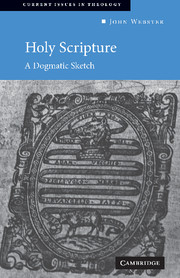1 - Revelation, sanctification and inspiration
Published online by Cambridge University Press: 05 June 2012
Summary
Holy Scripture is not a single or simple entity. The term ‘Holy Scripture’ refers primarily to a set of texts, but importantly and secondarily to its divine origin and its use by the church. Thus the content of the term can only be thoroughly mapped by seeing this set of texts in connection with purposive divine action in its interaction with an assemblage of creaturely events, communities, agents, practices and attitudes. To talk of the biblical writings as Holy Scripture is ultimately to refer to more (but not to less!) than those writings per se. It is, on the one hand, to depict these texts in the light of their origin, function and end in divine self-communication, and, on the other hand, to make recommendations about the kinds of responses to these texts which are fitting in view of their origin, function and end. ‘Holy Scripture’ is a shorthand term for the nature and function of the biblical writings in a set of communicative acts which stretch from God's merciful self-manifestation to the obedient hearing of the community of faith.
The sufficiency of Scripture, that is, is not quite the same as its ‘self-sufficiency’. Yet whilst ‘Holy Scripture’ does refer to a composite reality (texts in relation to revelation and reception), there is a definite order to its elements.
- Type
- Chapter
- Information
- Holy ScriptureA Dogmatic Sketch, pp. 5 - 41Publisher: Cambridge University PressPrint publication year: 2003
- 1
- Cited by



